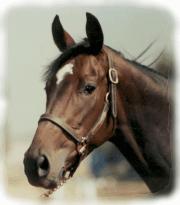A Horse, of Course with Don Blazer |
If you enjoy learning about horses, then you'll love our online courses. Each month you'll find a new column on our web site. We hope you'll enjoy it, and maybe e-mail us with questions or suggestions for other columns. A Horse, Of Course is a monthly column syndicated by Success Is Easy. If you like the column, call your local newspaper, or local horse publication and ask them to subscribe by contacting Success Is Easy. |
The Dynamic Equine Hoof Don Blazer copyright©2011 Some things are so true you hate to hear them…such as: "I hate to tell you so, but I told you so." One of the things I hate to hear most is, "I leave my horse's feet to my farrier." People who say that usually don't have a clue about their horse's feet. You can bet they don't know how the hoof functions, what creates a balanced hoof, or what is good shoeing. If they did, they wouldn't abdicate their responsibility as a horse owner…..hoof care is just too important to leave to someone else. (I'm not saying you need to be able to trim or shoe a horse….I'm saying you better know as much about the trimming and shoeing of a horse as the person doing the work.) The truest thing you can say about a hoof is, "no hoof, no horse." It's so true that nine times out of 10, when a horse is lame, the problem is in the hoof. And the one time it isn't, a hoof is probably a contributing cause. A horse's hoof - if you stretch the comparison - is the same as the fingernail of a person's middle finger. Still comparing, the thumb and little finger were transformed long ago in the horse's ergot and the chestnut. The index finger and the third finger are now splint bones. The horse's foot has a functional configuration, is elaborate and surprisingly, has a lot of moving parts. The front foot should be large and very round to be the perfect base to support the front leg, which supports the mass of the horse's body as it travels forward. The hind hoof is smaller and elongated so that it digs into the ground surface as it propels the horse forward. As the hoof hits the ground, preferable flat, the hoof's quarters expand outward if the hoof is balanced, naturally shaped and not poorly shod. (There are a lot of poorly shod horses whose quarters can't expand because they are "nailed" inside a steel box. Any horse whose shoe is not wider than his hoof from the quarters back is poorly shod.) As the quarters expand, so does the digital cushion (inside the hoof) which presses against the lateral cartilages, further expanding the quarters. While this is happening, the short pastern bone presses the digital cushion against the frog and the frog moves downward toward the ground. The frog must contact the ground to absorb concussion and compression. The digital cushion and frog are important factors in slowing the decent of the back of the coffin bone. Don't allow the paring of the frog. The frog should contact the ground and be the same depth as the shoe. Excessive frog will slough off naturally. When the hoof hits the ground, a direct concussive force is exerted upward through the multiple horn tubules-spring like spirals in the hoof wall. The hoof wall is connected to the coffin bone inside the hoof by the interlocking of insensitive and sensitive laminae. The narrow, but strong hoof wall absorbs the upward force of concussion created when the hoof hits the ground, while the frog, digital cushion, coffin bone and laminae absorb the downward force of the horse's body weight-the compressive force. Compressive force is so powerful it causes hoof bruises if the hoof is not able to expand enough to absorb the shock. Many of the bruises termed "stone" bruises are actually compressive force bruises. The hoof is a dynamic, live, complicated structure which works quite well if strong, pliable, healthy and balanced. Most horsemen agree any performance horse should be trimmed or shod every 30 days. The hoof wall of the average horse will grow about 3/8 of an inch in 30 days, changing the arc of the hoof flight. The maximum length of time between trims or shoeing should normally never exceed six weeks. If you don't know as much about your horse's feet and how they should be cared for, then it won't be long before you'll be hearing me say, "I hate to tell you so, but I told you so." |
